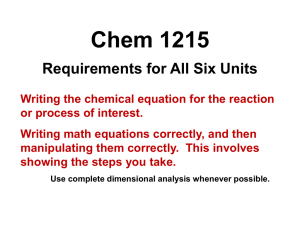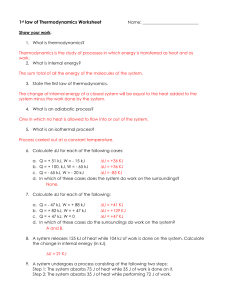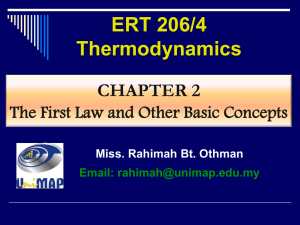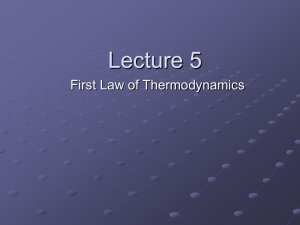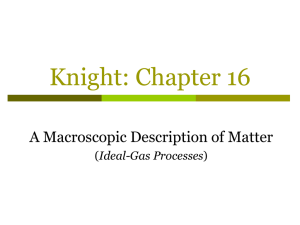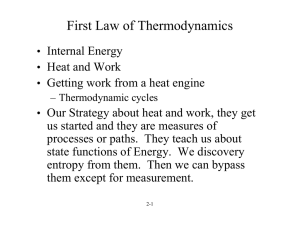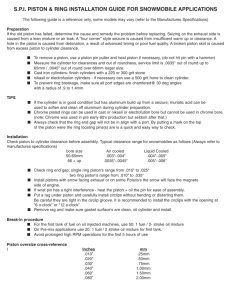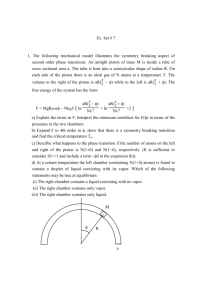1st Law of Thermodynamics Worksheet
advertisement
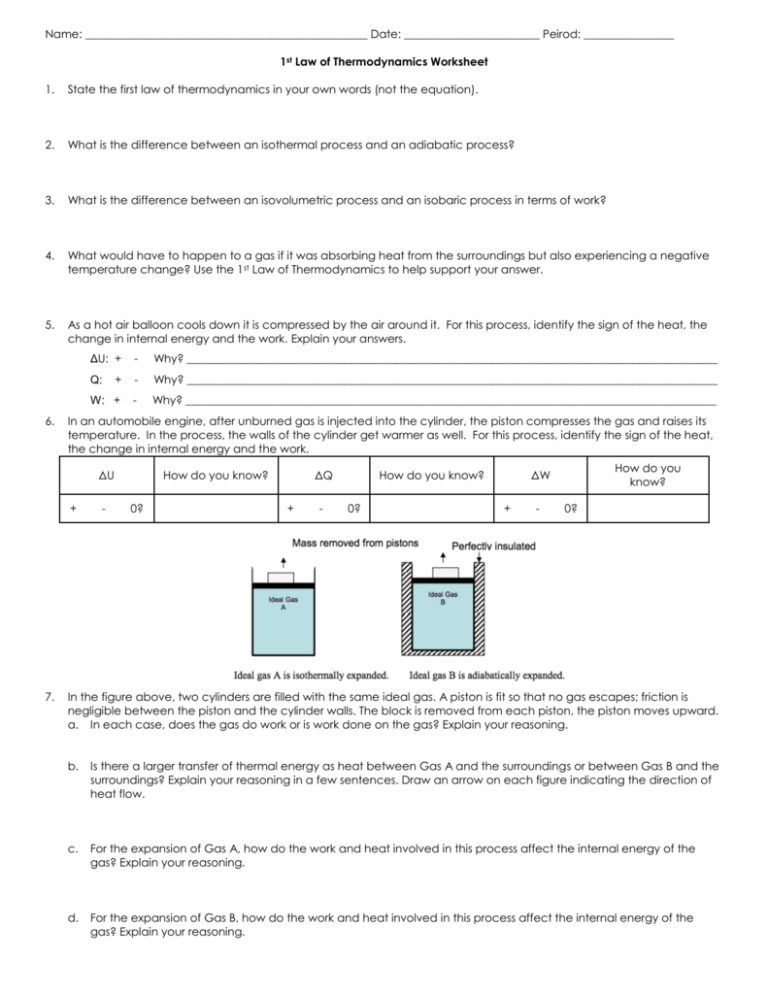
Name: __________________________________________________ Date: ________________________ Peirod: ________________ 1st Law of Thermodynamics Worksheet 1. State the first law of thermodynamics in your own words (not the equation). 2. What is the difference between an isothermal process and an adiabatic process? 3. What is the difference between an isovolumetric process and an isobaric process in terms of work? 4. What would have to happen to a gas if it was absorbing heat from the surroundings but also experiencing a negative temperature change? Use the 1st Law of Thermodynamics to help support your answer. 5. As a hot air balloon cools down it is compressed by the air around it. For this process, identify the sign of the heat, the change in internal energy and the work. Explain your answers. ΔU: + - Why? ______________________________________________________________________________________________ + - Why? ______________________________________________________________________________________________ W: + - Why? ______________________________________________________________________________________________ Q: 6. In an automobile engine, after unburned gas is injected into the cylinder, the piston compresses the gas and raises its temperature. In the process, the walls of the cylinder get warmer as well. For this process, identify the sign of the heat, the change in internal energy and the work. ΔU + 7. - How do you know? 0? ΔQ + - How do you know? 0? How do you know? ΔW + - 0? In the figure above, two cylinders are filled with the same ideal gas. A piston is fit so that no gas escapes; friction is negligible between the piston and the cylinder walls. The block is removed from each piston, the piston moves upward. a. In each case, does the gas do work or is work done on the gas? Explain your reasoning. b. Is there a larger transfer of thermal energy as heat between Gas A and the surroundings or between Gas B and the surroundings? Explain your reasoning in a few sentences. Draw an arrow on each figure indicating the direction of heat flow. c. For the expansion of Gas A, how do the work and heat involved in this process affect the internal energy of the gas? Explain your reasoning. d. For the expansion of Gas B, how do the work and heat involved in this process affect the internal energy of the gas? Explain your reasoning. 8. A platter of birdseed is mounted on top of a gas-filled piston. As the birdseed on top of the platter is eaten, the gas expands isothermally and does 4.17 J of work. How much heat is transferred during this process? 9. Calculate the work done on or by a system that absorbs 260 kJ of heat experiences a change in internal energy of 157kJ. Does the system expand or contract? How do you know? 10. A system releases 125 kJ of heat while 104 kJ of work is done on the system. Calculate the change in internal energy. 11. A heat engine undergoes a process in which its internal energy decreases by 400.0 J while it is doing 250 J of work. What is the net heat is taken in (or given out) by the engine during this process? 12. 3000 J of heat is added to a system while 2000 J of work is done on the system. What is the change in internal energy? 13. A system undergoes a process consisting of the following two steps: Step 1: The system absorbs 73 J of heat while 35 J of work is done on it. Step 2: The system absorbs 35 J of heat while performing 72 J of work. Calculate the change in internal energy for the overall process (in J). 14. A system does 450 J of work that results in an increase in internal energy of 450 J. a. How much heat is added or removed? b. Does temperature increase, decrease, or remain the same? Explain. 15. When you pump a bicycle pump quickly, the compression is almost adiabatic because there isn’t much time for the gas to exchange energy with anything. During a single pump, you do 36 J of work on 4.26 x 10 -4 kg of air inside the cylinder. How much does the internal energy of the air inside the pump change during a single pump? 16. A battery harnesses a chemical reaction to extract energy in the form of useful electrical work. a. A certain battery runs a toy truck and becomes partially discharged. In the process, it performs a total of 117.0 J of work on its immediate surroundings. It also gives off 3.0 J of heat, which the surroundings absorb. No other work or heat is exchanged with the surroundings. Compute q, w, and ΔU of the battery, making sure each quantity has the proper sign. ΔU: + - ___________ Why? ___________________________________________________________________________________ Q: + W: + - ___________ Why? ___________________________________________________________________________________ - ___________ Why? ___________________________________________________________________________________ b. The same battery is now recharged exactly to its original condition. This requires 210.0 J of electrical work from an outside generator. Determine Q for the battery in this process. Explain why q has the sign that it does.



